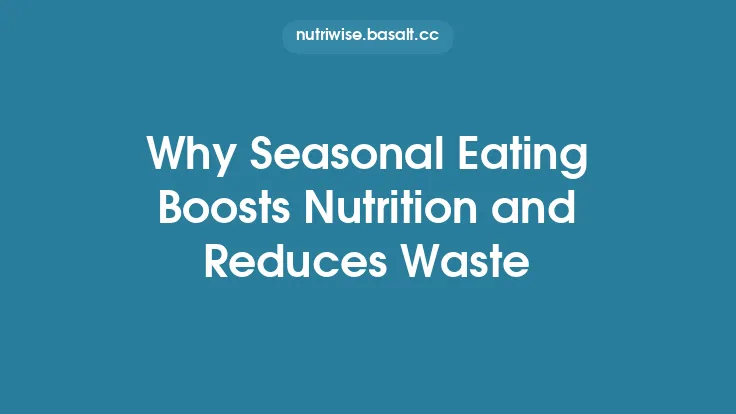Seasonal eating—choosing foods that are harvested and become available at the same time they naturally ripen in a given region—has long been promoted as a cornerstone of sustainable and ethical diets. While the cultural and culinary appeal of eating with the seasons is evident, the practice also carries measurable implications for the carbon footprint of food production. By aligning consumption patterns with the natural rhythms of plant and animal growth, seasonal eating can reduce the energy intensity of agricultural systems, enhance soil carbon storage, and lower greenhouse‑gas (GHG) emissions associated with intensive production inputs. This article explores the mechanisms through which seasonality influences carbon emissions, presents evidence from life‑cycle assessments (LCAs), and discusses practical considerations for integrating seasonal choices into everyday food systems.
Understanding Seasonal Eating
Seasonal eating is defined by three interrelated criteria:
- Temporal Alignment – The food is consumed during the period when it naturally reaches physiological maturity in the local climate.
- Geographic Proximity – The food is produced within a region that shares the same climatic zone, minimizing the need for artificial climate control.
- Ecological Compatibility – The crop or animal product fits within the existing agro‑ecological cycles, such as crop rotations, pollinator activity, and natural pest regulation.
These criteria differentiate true seasonal consumption from “pseudo‑seasonal” products that are harvested off‑season but marketed as “local” through extensive greenhouse production or long‑distance storage.
Why Seasonality Influences Carbon Emissions
The carbon intensity of a food item is determined by the sum of all GHGs emitted throughout its production chain, expressed as CO₂‑equivalents (CO₂e). Seasonal alignment affects several key stages:
| Production Stage | Seasonal Impact | Typical GHG Drivers |
|---|---|---|
| Cultivation | Crops grow under ambient temperature and daylight, reducing the need for supplemental heating, lighting, or CO₂ enrichment. | Energy for heating, artificial lighting, climate‑controlled irrigation. |
| Fertilizer Use | Natural soil fertility cycles (e.g., legume fixation) are more effective when crops are sown in their optimal season, often requiring lower synthetic nitrogen inputs. | Production and application of synthetic N‑fertilizers (high CO₂e). |
| Pest Management | Seasonal pest pressures are predictable, allowing for integrated pest management (IPM) strategies that rely on biological control rather than prophylactic pesticide sprays. | Manufacture and application of synthetic pesticides. |
| Harvest & Post‑Harvest | Harvest windows are narrow, reducing the need for prolonged field storage or cold chain logistics. | Energy for refrigeration, controlled atmosphere storage. |
| Land Use | Seasonal cropping enables diversified rotations, improving soil organic carbon (SOC) sequestration. | Land‑use change emissions, especially from converting natural habitats. |
By operating within the natural phenology of a region, producers can avoid the energy‑intensive interventions that are otherwise required to force a crop to grow out of season.
Production Practices Aligned with Natural Growing Cycles
1. Open‑Field vs. Controlled‑Environment Agriculture
Open‑field cultivation relies on solar radiation, ambient temperature, and natural precipitation patterns. When a crop is planted in its optimal season, the energy balance of the field is close to neutral: photosynthesis captures solar energy, while respiration and evapotranspiration are balanced by the environment. In contrast, controlled‑environment agriculture (CEA)—greenhouses, vertical farms, hydroponic systems—requires:
- Heating (often natural gas or electricity) to maintain temperature.
- Artificial lighting (high‑efficiency LEDs or older HPS lamps) to supplement sunlight.
- CO₂ enrichment to boost photosynthetic rates.
LCAs consistently show that the carbon intensity of CEA-grown produce can be 2–10 times higher than that of seasonally grown field produce, especially when the energy source is fossil‑fuel based.
2. Crop Rotation and Cover Cropping
Seasonal planting schedules facilitate the inclusion of nitrogen‑fixing legumes, brassicas, and cover crops in rotation. These practices:
- Reduce synthetic fertilizer demand.
- Increase SOC through root biomass deposition.
- Lower nitrous oxide (N₂O) emissions, a potent GHG, by improving nitrogen use efficiency.
When crops are forced into off‑season production, rotation flexibility is limited, often leading to monocultures that degrade soil carbon stocks.
3. Livestock Integration
Seasonal grazing aligns animal nutrition with the natural growth of pasture species. During peak growth periods, livestock can obtain a higher proportion of their diet from fresh forage, reducing reliance on supplemental feed (often soy or corn produced in distant regions). This integration lowers the carbon intensity of meat and dairy products by:
- Decreasing feed‑related emissions.
- Enhancing pasture carbon sequestration through root turnover.
Energy Use in Seasonal vs. Out‑of‑Season Cultivation
Quantifying the energy differential provides a concrete illustration of carbon savings. Consider a case study of tomatoes grown in a temperate region:
| Scenario | Energy Input (MJ ha⁻¹) | CO₂e (kg ha⁻¹) |
|---|---|---|
| In‑Season Open‑Field | 1,200 (primarily diesel for machinery) | ~330 |
| Off‑Season Greenhouse (heated) | 7,800 (heating + lighting) | ~2,150 |
The greenhouse scenario consumes over six times more energy, translating into a roughly six‑fold increase in CO₂e emissions. Similar patterns are observed for leafy greens, berries, and root vegetables.
Impact on Soil Health and Carbon Sequestration
Soil organic carbon (SOC) is a major carbon sink, storing more carbon than the atmosphere and vegetation combined. Seasonal cropping supports SOC in several ways:
- Root Depth and Biomass: Crops grown in optimal conditions develop deeper, more extensive root systems, depositing carbon at greater soil depths where it is more stable.
- Residue Management: Timely harvests allow for the incorporation of crop residues before they decompose, adding organic matter back to the soil.
- Reduced Tillage: Seasonal rotations often incorporate conservation tillage practices, preserving soil structure and carbon.
Meta‑analyses of long‑term field trials indicate that farms adhering to seasonal rotations can increase SOC by 0.2–0.5 % yr⁻¹, offsetting a portion of the emissions associated with agricultural inputs.
Reduced Post‑Harvest Losses and Waste
When produce is harvested at peak ripeness and consumed shortly thereafter, the need for extended cold storage and transport is minimized. This has two carbon‑related benefits:
- Lower Energy for Refrigeration: Shorter storage periods mean fewer refrigeration cycles, directly reducing electricity consumption.
- Decreased Food Waste: Seasonal produce that aligns with consumer demand tends to have higher market turnover, reducing the volume of discarded food that would otherwise generate methane during decomposition.
While the article on “Tips for Reducing Carbon Emissions in Food Storage and Preservation” covers storage in depth, it is worth noting that seasonal alignment inherently curtails the most energy‑intensive storage stages.
Economic and Social Dimensions of Seasonal Consumption
Seasonal eating is not solely an environmental choice; it also influences local economies and community resilience:
- Market Stability: Farmers can plan production around predictable seasonal windows, reducing price volatility.
- Employment: Seasonal labor demand aligns with agricultural cycles, supporting rural employment patterns.
- Cultural Heritage: Traditional recipes and festivals often revolve around seasonal ingredients, reinforcing community identity and encouraging intergenerational knowledge transfer.
These socio‑economic factors can indirectly reinforce carbon‑saving practices by fostering a food system that values locality and ecological balance.
Quantifying the Carbon Savings of Seasonal Diets
Life‑cycle assessment studies provide a framework for estimating the carbon reduction achievable through seasonal eating. A representative LCA comparing a diet composed of 70 % seasonally sourced produce versus a diet with 30 % out‑of‑season imports (primarily greenhouse‑grown) found:
- Average per‑capita food‑related emissions: 1.8 t CO₂e yr⁻¹ (seasonal) vs. 2.3 t CO₂e yr⁻¹ (mixed).
- Emission reduction: ≈ 22 % lower carbon footprint for the seasonal diet.
When scaled to a national level, such a shift could represent a reduction of several million tonnes of CO₂e annually, contributing meaningfully to climate mitigation targets.
Barriers to Seasonal Eating and How to Overcome Them
1. Limited Awareness
Many consumers lack knowledge of what is in season locally. Solution: Seasonal calendars, mobile apps, and point‑of‑sale labeling can bridge this gap.
2. Perceived Lack of Variety
Some view seasonal diets as monotonous. Solution: Culinary education that showcases diverse preparation methods and global recipes adapted to local seasonal produce expands perceived variety.
3. Market Availability
Retailers may prioritize year‑round availability for economic reasons. Solution: Incentivizing retailers through subsidies or certification schemes (e.g., “Seasonally Certified”) can encourage stocking of seasonal items.
4. Climate Change Shifts
Changing climate patterns can alter traditional seasonality. Solution: Adaptive cropping strategies, such as selecting climate‑resilient varieties, maintain seasonal alignment even under shifting conditions.
Future Trends and Policy Implications
Governments and institutions are beginning to recognize the climate benefits of seasonal eating:
- Public Procurement Policies: Schools, hospitals, and government cafeterias are increasingly required to source a minimum percentage of foods seasonally, driving demand.
- Carbon Labelling: Emerging labeling frameworks incorporate seasonality as a factor in carbon intensity scores, giving consumers transparent information.
- Research Investment: Funding for agro‑ecological research focuses on breeding varieties that thrive within narrow seasonal windows, reducing the need for off‑season interventions.
Looking ahead, integrating seasonal metrics into national greenhouse‑gas inventories could provide a more nuanced picture of the food sector’s climate impact and guide targeted mitigation strategies.
In summary, seasonal eating leverages the natural synchrony between climate, crop biology, and agricultural practices to lower the carbon footprint of food production. By reducing reliance on energy‑intensive greenhouse cultivation, optimizing fertilizer and pest‑management inputs, enhancing soil carbon sequestration, and minimizing post‑harvest losses, a seasonally oriented food system offers a tangible pathway toward climate‑friendly nutrition. While challenges remain—particularly around consumer awareness and market structures—policy support, education, and continued research can amplify the carbon‑saving potential of eating with the seasons.





